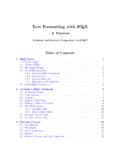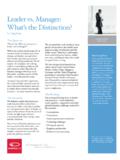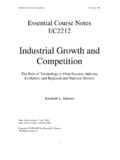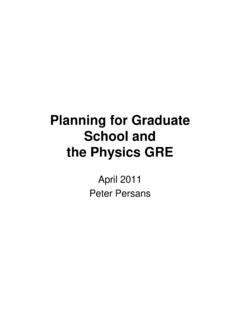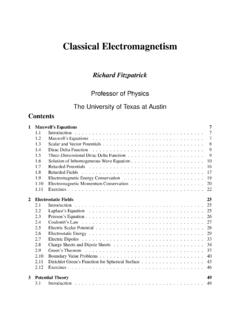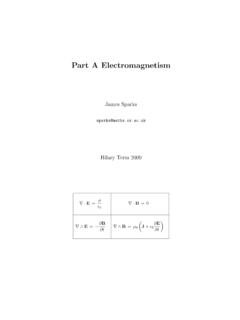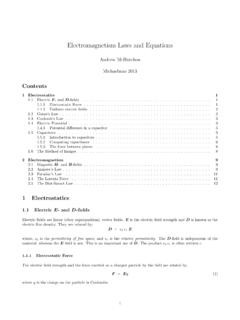Transcription of Electromagnetic Units - Rensselaer Polytechnic Institute (RPI)
1 APPENDIX AElectromagnetic UnitsTwo divergent systems of Units established themselves over the course of the 20th century. One system, known asSI(from the French Le Syst`eme International d unit es), is rooted in the laboratory. It gained favor in the engineeringcommunity and forms the basis for most undergraduate curricula. The other system, calledGaussian, is aestheticallycleaner and is much favored in the theoretical physics community. We useGaussianunits in this book, as do mostgraduate level physics is also known asMKS(for meter, kilogram, second), and theGaussianis calledCGS(forcentimeter, gram, second) Units . For problems in mechanics, the difference is trivial, amounting only to some powersof ten.
2 The difficulty comes when incorporating electromagnetism , however, where charge, for example, actually hasdifferent dimensions for the two sets of appendix attempts to contrast the two systems of Units , with respect to electromagnetism . Some formulasare given which should make it easy for the reader to follow the discussions in this and other graduate level COULOMB S LAW, CHARGE, AND CURRENTC oulomb s law is the empirical observation that two chargesQ1andQ2attract or repel each other with a forceFQthatis proportional to the product of the charges and inversely proportional to the square of the distancerbetween is most natural to write this asFQ=Q1Q2r2 Gaussian( )This is in fact the starting point for definingGaussianunits.
3 The Units of charge are calledstatcoulombs, and the forcebetween two charges of one statcoulomb each separated by one centimeter is one is easy to see why such a delightfully simple formulation caught on in the physics community. Unfortunately,though, it is difficult to realize experimentally. It is much easier to set up a current source in the laboratory, perhapswith a battery driving a circuit with an adjustable resistance. Furthermore, magnetic forces between long wires arestraightforward to measure. Therefore, theSIsystem is borne out of the definition of theampere, namelyOne ampere is that steady current which, when present in each of two long parallel conductors, separatedby a distancedof one meter, results in a force per meter of lengthFI/Lbetween them numerically equalto 2 10 7 simple force formula for theSIsystem, analogous to Coulomb s law for theGaussiansystem, isFIL= 02 I1I2dSI( )for currentsI1andI2(measured in amperes) in each of two wires.
4 Although ( ) doesn t carry a popularized name,it is as fundamental to theSIsystem of Units as Coulomb s law ( ) is to UnitsTABLE :Maxwell s equations in the absence of Law (E) E=4 (x) E=1 0 (x)Gauss Law (M) B=0 B=0 Ampere s Law B c E t=4 cJ B ( 0 0) E t= 0 JFaraday s Law E+ B t=0 E+ B t=0 Lorentz Force LawF=Q(E+vc B)F=Q(E+v B)Based on the definition of the ampere, we must have 0 4 10 7N/A2( )Factor of 4 frequently appear in formulations of electromagnetism because one is always bound to integrate over theunit sphere. It is a matter of taste, and now convention, whether to take them out in the beginning or carry them aroundat the one defines a unit of charge called theCoulombas the charge passing through a wire carrying a current ofone ampere during a time of one second, then Coulomb s law becomesFQ=14 0Q1Q2r2SI( )With this definition of the proportionality constant, one eventually shows that the speed of Electromagnetic waves infree space isc=1 0 0( )In our current standard Units , the speed of lightcis a defined quantity.
5 Hence, 0is also defined to be an exact relation like ( ) is of course no surprise. Electric and magnetic fields are related to each other throughLorentz transformations, so the proportionality constants 0and 0should be related throughc. InGaussianunits,there are no analogues of 0or 0, butcappears explicitly CONVERTING BETWEEN SYSTEMSE lectromagnetism can be developed by starting with ( ) or ( ) and incorporating special relativity. For exam-ple, one first writes down Gauss Law as E= (x)/ 0SI( )or E=4 (x)Gaussian( )for the electric fieldE(x). The remaining Maxwell s equations are then determined. Table displays Maxwell sequations in the two sets of Units , as well as the Lorentz force law, in vacuum.
6 From here, all else follows, and onecan derive all the results in electromagnetism using one set of Units or course it is easiest to take one set of derivations and convert into the other after the fact. For example,( ) and ( ) tell us that to make the conversionGaussian SI( )for Gauss law, we just make the changeQ 1 4 0Q( )Then, referring to the Lorentz force law in Table we see thatE 4 0E( )andB c 4 0B= 4 0B( ) CONVERTING BETWEEN SYSTEMS349If you are ever confused, always try to relate things back to a purely mechanical quantity like force or energy. Forexample, the potential energy for a magnetic moment in a magnetic field isU= B( )independent of which system of Units we are using.
7 Therefore, using ( ) we have 04 ( )and so, referring to the starting point of this textbook, the magnetic moment of a circulating chargeQwith angularmomentumLis =Q2mcLGaussian 04 =Q 4 012mcL( )or =Q2mLSI( )It is also useful to keep in mind that quantities likeQ2have dimensions of energy length inGaussianunits. This isgenerally enough so that you never have to worry about what a statcoulomb really is.

